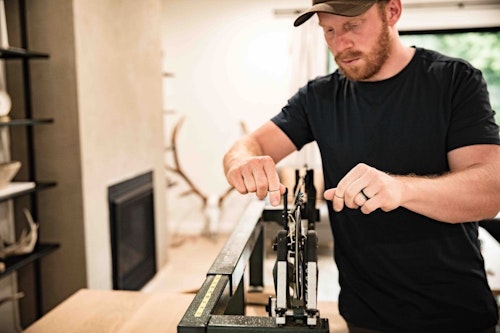
The author was highly impressed with the smoothness, minimal shot noise and accuracy the Alaskan delivered . . . all for a price of only $529.99.
Bear Archery is a unique bow company in several ways, and I’ll mention a few of them. Most notable is the brand’s storied existence — legendary Fred Bear started Bear Archery way back in 1933. Second, it offers both traditional bows and modern compounds, as well as crossbows. But what’s quite evident when perusing Bear’s current lineup is that the brand hasn’t forgotten one of bowhunting’s often overlooked joys: simplicity. Yes, it has loaded high-end compounds, but it also has affordable bows with just enough technology. Enter the Bear Alaskan.
The hunting community needlessly overcomplicates bowhunting. We’ve created illegitimate barriers to entry for outsiders looking to get started. And for those who’ve been bowhunting a long time, we often feel disadvantaged if we can’t afford the latest high-end bow or a matching Sitka Gear camo outfit. There’s nothing wrong with wanting technical equipment, but the inability to own it doesn’t solely dictate success or failure.
The Hunting Public and its hit YouTube channel proves my point. The team previously hunted with high-end compound bows, but now, most of the team shoots Bear bows that most folks on budgets can afford. They do it to show the hunting community that bowhunting is affordable, and that value-priced equipment does the job. The message is clear, because they’re as successful with budget bows as they were with high-end bows.
That brings me to this point: Testing the new Bear Alaskan was refreshing because it’s not flashy or loaded with features too many to name. If I was a budget bow buyer or just looking to simplify and minimize, I’d buy the Alaskan in a heartbeat and carry it confidently, whether sitting feeders for Texas hogs or calling in a Yukon moose. Here’s why.
Test Bow Specs
- Axle to Axle Length: 32 inches
- Brace Height: 6.25 inches
- Draw Length: 28 inches
- Draw Weight: 66.4 pounds
- Let-off: 80%
- Bow-only Weight: 3.9 pounds
- Accessorized Total Weight:
- 5.3 pounds
- Velocity: 266 fps (with 468-grain Easton 6.5mm Acu-Carbon 340 arrow)
- Kinetic Energy: 73.52 foot-pounds
- Finish: Olive
- MSRP: $529.99
- Contact: www.beararchery.com
First Impressions
Most of the world’s most accomplished bowhunters would agree with me that the bow grip can make or break the way a bow performs, especially in a fast-paced hunting situation that requires you to draw and shoot quickly. Coming from a guy who’s held and shot dozens of different bows over the last 20-some years, the Alaskan has an extremely comfortable grip that was easy for me to grip consistently. I’m sure most will agree.
The Alaskan’s modern yet uncomplicated styling exemplifies what bowhunters seeking simplicity expect in a new bow. It’s available in Mossy Oak Break-Up Country, Throwback Black, and Olive. My test bow came in Olive, and I immediately appreciated the tactical flavor.
I specifically set up the Alaskan as perhaps a typical budget bow buyer would. I bolted on a Trophy Ridge Whisker Biscuit V Max rest and single-pin HHA slider sight. An HHA Tetra stabilizer was the final touch before I walked outside into the sweltering 90-degree temps with humidity hovering at 80 percent to test the Alaskan. Next, I’ll discuss how it performed.
Overdelivering on Expectations
I temper my expectations any time I shoot an affordable bow. I usually expect to dig deep to find a lot of good things to say, but that simply wasn’t the case with the Alaskan. First, its smoothness while drawing is outstanding. Granted, the test bow maxed out at only 66.4 pounds (not 70, like I expected), but still, it felt like 60. The smoothness is the product of new non-radical DHC Hybrid Cam, which lets off 80 percent and adjusts from 25.5-31 inches.
The Alaskan’s stability doesn’t quite match that of most high-end bows, but we’re talking about a bow that retails for half or even less than half of what typical high-end bows do. From 20-50 yards, I had no trouble settling my pin, hovering it on the kill zone on my 3-D targets and executing precise shots. For the price, and considering that most who’ll buy the Alaskan aren’t 70-yard shooters, I believe it delivers plenty of stability, especially when paired with a decent stabilizer.

As for accuracy, I got dialed at 20 yards within minutes. Every time I shoot the Alaskan at 20-30 yards, I can hit a 12-ring as long as I do my part. At 40 yards, my groups were 2 inches (diameter) and smaller. Let me add that I took the time to send some fixed-blade broadheads from 40 yards to see if the Alaskan’s broadhead accuracy mirrored its field-point accuracy. It does. With zero tinkering, both a Helix 100 and Muzzy One hit right with my field points. I’ve had numerous bows over $1,000 that required extensive tinkering to get true fixed-blade flight, so the Alaskan gets high honors from me in that department.
I spent some time walking up to targets and shooting from odd and random distances. Whether it was 17 yards or 37, I found it easy to put arrows where I wanted them. Whether you’re a meat hunter or you’ll be chasing a 200-inch buck this season, the Alaskan won’t let you down in the accuracy department as long as you do your part to execute good shots. It’s extremely deadly.
And talk about quiet and vibration-free. I expect some of each from a value bow, but the Alaskan is quieter than some high-end bows I’ve tested. No kidding. I didn’t shoot it without a stabilizer, but with the HHA Tetra, I felt no hand shock at all. I’m telling you, this bow leaves very little to be desired.
Final Thoughts
I prefer a dead-solid back wall, and while the Alaskan has draw stops, the back wall was just a little bit softer than I’m used to. I took care to focus on the amount of pressure I imparted on the wall to ensure consistency. That is the only thing I could complain about it, but it didn’t seem to affect my performance, and I assume bowhunters who aren’t technical like me won’t notice the difference.
If you like how I have reviewed the Alaskan but you’re a technology nut, then I would suggest looking at Bear Archery’s high-end Refine EKO or Redemption EKO, which are still more affordable at $999 than most competing flagship compound bows. These are loaded with more technologies, and if you’re looking to push the envelope to greater distances, these will likely produce a bit more stability, accuracy and overall performance.
That said, if you’re tired of bowhunting being needlessly complicated, or you just don’t have $1,000 to spend on a new compound, why not give the Alaskan a shot? It’s a no-nonsense bowhunter’s bow through and through. And whether you’re sniping Texas hogs over a feeder or taking aim at a once-in-a-lifetime Yukon moose as he swaggers toward an opening 35 yards away, if you do your part, the Alaskan will deliver an accurate arrow. I have no doubts about it. And what more can you ask of a $529.99 bow?
Additional Notes
The Bear Alaskan was set up using a Last Chance Archery EZ Green Bow Press and EZ Green Bow Vise, and draw weight was calculated using Last Chance Archery’s Digital Bow Scale. A Caldwell Ballistic Precision Chronograph measured the 468-grain Easton 6.5mm Acu-Carbon 340 arrow’s velocity.
In-the-field photos by Darron and Rebecca McDougal







